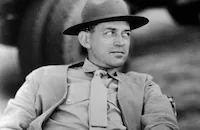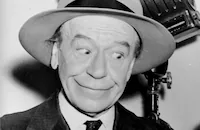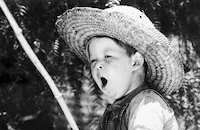Love on the Run

Brief Synopsis
Cast & Crew
W. S. Van Dyke
Joan Crawford
Clark Gable
Franchot Tone
Reginald Owen
Mona Barrie
Film Details
Technical Specs

Synopsis
Rival London-based American newspaper correspondents Michael Anthony and Barnabas Pells flip a coin to determine who will cover which of two boring assignments. Mike gets the story about millionairess Sally Parker's wedding to Prince Igor, while Barney takes an interview with aviator Baron Otto Spandermann and his wife Hilda. On the way into the wedding, Mike sees Sally running out of the church and follows her, hoping to get a story. At her hotel, he runs into the suspicious Barney, but doesn't tell him what just happened, then sneaks into Sally's hotel room, and telling her that he has admired her for years, suggests that he help her "get away from it all." When the gigolo prince comes to the hotel, Mike slugs him when the prince recognizes him as a reporter, and he and Sally decide to run away, using the baron and baroness' flying suits as disguises. Barney chases them to the airport, but is too late and they fly away, though neither is a pilot. Just before they crash land in France, they find a munitions map in a bouquet of flowers intended for the baroness and realize that the aviators are spies. Though Mike has sent a secret cablegram about Sally to his editor Berger in New York, he is even more excited about the spy story. In Paris, after getting money from his paper, Mike and Sally are found by Barney, then are spotted by the baron and baroness. As they flee, Barney comes along until Mike pushes him into the back of the truck they steal and convinces Sally that Barney is a lowlife reporter. By nightfall, they arrive at the Palace of Fontainbleau and sneak in to spend the night. During the evening, they realize that they are in love, and Mike tries to tell her that he is a reporter, but can't. Next morning, Barney finds them again, but Sally doesn't believe him when he accuses Mike of being a reporter, too. Soon, however, an ashamed Mike gives her a newspaper with his byline and she realizes what he has done. He apologizes and tells her he loves her, but she sends him away. When Barney arrives, she says she will give him the greatest story of his career, and they go off to make headlines. A short time later, while they are traveling by train to Nice, Sally realizes that she still loves Mike and wants to go to him, but just then the baron and baroness come into their compartment with guns and demand that Sally give them the map. They search Sally but do not find it and leave her after pushing Barney off the train. When Barney catches up with Mike at a cafe in Paris and tells him what has happened, Mike decides to go to Nice himself to save Sally. In Nice, Mike is lovingly reunited with Sally at her hotel and they go to the train station. In the station, the baroness switches clothes with Sally in the ladies room, then goes with Mike, posing as Sally. The baron then finds Sally and takes her to a restaurant. She tries to contact the police, but when two policemen arrive, they believe the baron's story that she stole his plane. The baron then kidnaps Sally and the policemen and takes them to his chateau, where the baroness has taken Mike. Having followed Mike and the baroness, thinking that she was Sally, Barney also arrives. Using various ruses, Mike, Sally and the policemen eventually overwhelm the baron and baroness and Sally and Mike go off, leaving Barney tied-up, but Mike has a change of heart and returns, once again finding Barney trying to get his story first by using the chateau phone to cable his editor. They finally agree to file a joint byline, and Sally and Mike agree that they will soon be married.

Director

W. S. Van Dyke
Cast

Joan Crawford

Clark Gable

Franchot Tone

Reginald Owen

Mona Barrie
Ivan Lebedeff

Charles Judels

William Demarest

Donald Meek
Charles Trowbridge

Billy Gilbert

Frank Puglia
Adia Kuznetzoff

Leonid Kinsky

Christian Rub
Dewey Robinson

Bobs Watson
Betty Jane Graham
George Davis
Harry Allen
James B. Carson
Reynolds Denniston
Egon Brecher
Richard Lancaster
Donald Kerr

Charles Irwin
Otto H. Fries
Elsa Buchanan
Viola Moore
Nanette Lafayette
Alice Ardell
Norman Ainsley
Jimmie Aubrey
Robert Cory
Gunnis Davis
Douglas Gordon
Frank Du Frane
E. L. Fisher-smith
Martha Mayo
John Power
Montague Shaw
Yorke Sherwood
Tom Herbert
Joe Mack
Charles De Ravenne
Duke York
Agostino Borgato
Fred Cavens

Fred W. Malatesta
Gennaro Curci
Alphonse Martell
Frank Mayo
Genaro Spagnoli
Jacques Vanaire
Bobby Watson
Robert Du Couedic

George Andre
Dick Alexander
Lilyan Irene
Margaret Marquis
Eleanor Stewart
Jack De Wees
Crew
Adrian
Tom Andre
Julian Brodie
Clarence Brown
Cedric Gibbons
Alan Green
Gladys Hurlbut
Gus Kahn
John Lee Mahin
Joseph L. Mankiewicz
Bob Mark
Oliver T. Marsh
Harry Mcafee
Manuel Seff
Douglas Shearer
Frank Sullivan
W. S. Van Dyke
Franz Waxman
Franz Waxman
Edwin B. Willis

Photo Collections
Videos
Movie Clip
Trailer
Film Details
Technical Specs

Articles
Love on the Run (1936) - Love on the Run
Screwball comedy had also given new life to the careers of dramatic actresses like Irene Dunne and Claudette Colbert, and every drama queen in Hollywood was trying her hand at it, whether she had a talent for it or not. Joan Crawford's turn came with Love on the Run (1936), and MGM provided her favorite co-star for added marquee power. Gable and Crawford had proven to be a winning romantic team in six previous films, so re-teaming them in a screwball farce was a shrewd move.
Love on the Run takes off from the It Happened One Night premise of a runaway heiress in a love-hate relationship with a dashing reporter. But with typical MGM grandiosity, Love on the Run is set in Europe rather than the East Coast; the vehicle of escape is a plane, not a bus; and for good measure, there are two dashing reporters, Gable and Franchot Tone, competing for madcap heiress Crawford. There's also some international espionage, a top-notch supporting cast including Reginald Owen, Donald Meek and William Demarest, and the fast-paced direction of W.S. Van Dyke.
Gable and Crawford's off-screen affair had lasted almost as long as their onscreen one, through his first two marriages and hers to Douglas Fairbanks, Jr. Crawford recalled later that she and Gable had been drawn together by their working-class backgrounds, and by similar fears and insecurities. But by the time they made Love on the Run, Gable was involved with the love of his life Carole Lombard, and Crawford was still in the early days of her second marriage to Franchot Tone, who was also in the film. Gable and Crawford's passion had mellowed into a lasting friendship.
Crawford, fresh from being colossally miscast (at her own insistence) in her one and only period drama, The Gorgeous Hussy (1936), was happy to escape into the comedy of Love on the Run. "I enjoyed the hell out of it," she would say later. "Not a big picture, but everyone I know who saw it seemed to love the thing." That included the critics. "Clever direction, sophisticated dialogue, novel setting and ludicrous situations combined with excellent casting spell 'reel' entertainment," wrote John Mosher in the New Yorker. Crawford may not have had the gossamer-light touch of Colbert, but critics found her more than adequate. "Miss Crawford, of the big eyes and flowing hair, turns in a surprisingly volatile and amusing performance," according to Howard Barnes of the New York Herald Tribune.
At the time she made Love on the Run, Joan Crawford was still a top box-office draw, as she had been every year since 1932. But her career had peaked, and a few years later, she'd be labeled box office poison. Her marriage to Tone ended in 1939, and her MGM contract ended a few years later. But Crawford, the ultimate survivor, bounced back, finally winning her Oscar for Mildred Pierce (1945). Clark Gable also had his greatest role ahead of him, as Rhett Butler in Gone With the Wind (1939). He would remain a top star until his death in 1960.
Director: W.S. Van Dyke
Producer: Joseph L. Mankiewicz
Screenplay: John Lee Mahin, Manuel Seff, Gladys Hurlbut, based on the story by Alan Green & Julian Brodie
Cinematography: Oliver T. Marsh
Editor: Frank Sullivan
Costume Design: Adrian
Art Direction: Cedric Gibbons
Music: Franz Waxman
Principal Cast: Joan Crawford (Sally Parker), Clark Gable (Michael Anthony), Franchot Tone (Barnabas Pells), Reginald Owen (Baron Spandermann), Mona Barrie (Baroness), Ivan Lebedeff (Prince Igor), William Demarest (Editor), Donald Meek (Caretaker).
BW-81m. Closed captioning.
by Margarita Landazuri

Love on the Run (1936) - Love on the Run
Quotes
I wonder where we are. Get out those maps there, will ya.- Michael 'Mike' Anthony
What color is it down there?- Sally Parker
Pinkish brown.- Michael 'Mike' Anthony
Pinkish brown ... We're over Persia.- Sally Parker
Knock knock.- Barnabus W. 'Barney' Pells
Who's there?- Sally Parker
Machiavelli.- Barnabus W. 'Barney' Pells
Machiavelli who?- Sally Parker
Machiavelli good soup for ten dollars.- Barnabus W. 'Barney' Pells
Trivia
Notes
Although most sources list a running time of 80 or 81 minutes, Variety lists the picture as 70 minutes long for its New York opening. According to a production chart and the review in Hollywood Reporter, Clarence Brown directed portions of the picture for a brief period during W. S. Van Dyke's illness. According to various news items in Daily Variety and Hollywood Reporter, M-G-M originally bought the short story "Beauty and the Beat" for Myrna Loy and Robert Montgomery. Because Loy and Montgomery already had too many assignments, a re-write of the script was made to turn the picture into a vehicle for Montgomery and Jean Harlow, and later as a film for Harlow and Robert Taylor. In mid-June 1936, an Hollywood Reporter news item announced that Victor Fleming was to direct Harlow in the film. A short time later, Joan Crawford, Clark Gable and Robert Young were announced as the stars. Franchot Tone replaced Young just after the start of production. Production was delayed for several weeks when Van Dyke was assigned to complete the direction of The Devil Is a Sissy, and studio executives considered hiring another director for Love on the Run. In one of the film's scenes, Tone's character tries to cheer up Crawford's character with the following joke: "Knock-knock," "Who's there?," "Machiavelli," "Macchiavelli who?," "Machiavelli good soup for ten dollars." According to modern sources, "knock-knock" jokes began in 1936. This May have been the first of its type ever filmed.
















